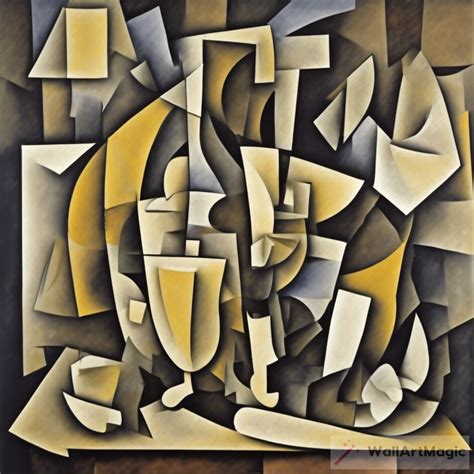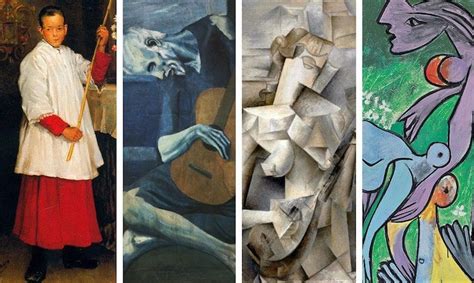As one delves into the depths of art history, it becomes apparent that certain names stand out, forever etching their mark on the artistic landscape. One such figure is the enigmatic artist who challenged the status quo and redefined the boundaries of creative expression. This article aims to shed light on the awe-inspiring journey of a visionary who left an indelible imprint on the canvas of modern art, transcending conventional norms and paving the way for a new era of artistic revolution.
Unconventional. Transformative. Innovative. These words merely scratch the surface in describing the profound impact of an artist who breathed life into form and substance. With an unparalleled ability to transcend the ordinary, this creative prodigy shattered the boundaries of artistic convention, paving the way for new possibilities. Through a mastery of technique and an insatiable hunger for experimentation, this visionary constantly pushed the envelope, forging a path that would forever change the face of art.
A polymathic force, known for his versatility and passion, this artistic luminary effortlessly transitioned between different styles and schools, leaving authorities scratching their heads in disbelief at his unfathomable genius. From cubism, surrealism, to the blue and rose periods, every stroke of his brush spoke volumes, captivating viewers and provoking thought. With each piece of art, this luminary transported spectators into uncharted realms of imagination, challenging them to question their perception and dive deep into the profound depths of human emotion.
Early Life and Artistic Beginnings

The early years and initial artistic endeavors of one of the most influential figures in the world of modern art are worth exploring. This section delves into the formative period of the renowned artist, highlighting the key experiences and early works that shaped his creative journey.
A table below captures the chronological highlights of Picasso's early life and artistic beginnings:
| Birth | Educational Background | First Artistic Influences | Artistic Exploration | Recognition and Growth |
|---|---|---|---|---|
| 1881 in Málaga, Spain | Early artistic studies at his father's studio | Affected by his father's painting techniques | Experimentation with different artistic styles | First exhibition and initial recognition as a young talent |
| Admitted to the Royal Academy of San Fernando | Exposure to classical art and techniques | Exploration of various art movements | Artistic breakthroughs and early critical acclaim | |
| Moved to Barcelona and attended La Llotja School of Fine Arts | Encounter with the works of Catalan modernists | Development of a unique artistic identity | Collaboration with avant-garde artists and writers |
During the early years and artistic beginnings, Picasso's journey was marked by a series of influential encounters, educational opportunities, and explorations of diverse artistic movements. These formative experiences set the stage for his later revolutionary contributions to the world of modern art.
Exploring Emotions through Color: The Blue and Rose Periods
Delving into the world of Pablo Picasso's early artistic periods, we uncover a captivating exploration of emotions through the masterful use of color. During the Blue and Rose Periods, Picasso embarked on a journey of self-expression, crafting profound pieces that resonated with viewers on a deep emotional level.
During the Blue Period, Picasso's works were characterized by a predominant palette of cool, melancholic hues. Shades of blue enveloped his canvases, depicting scenes of isolation, poverty, and despair. Through the somber tones and subdued atmosphere, Picasso conveyed a deep sense of sorrow and introspection, as if capturing the very essence of human vulnerability.
In contrast, the Rose Period witnessed a shift towards warmer tones, embracing shades of pink, orange, and beige. This period marked a departure from the somberness of the Blue Period, as Picasso delved into themes of love, joy, and optimism. His paintings portrayed circus performers, harlequins, and acrobats, evoking a sense of playfulness and whimsy. The vibrant colors brought these characters to life, enabling Picasso to convey a range of emotions and evoke a visceral response in viewers.
Through the skillful manipulation of color, Picasso transported audiences into a world where emotions were brought to the forefront. The Blue and Rose Periods allowed him to explore the depths of human experience, from despair to elation, and everything in between. By using color as a powerful tool, Picasso revolutionized the way art could evoke emotions and connect with its audience.
Cubism: Challenging Traditional Perspective

In this section, we delve into the revolutionary art movement known as Cubism, which emerged as a reaction against conventional artistic practices. Cubism, characterized by its fragmented forms and multiple perspectives, challenged the traditional notions of perspective and representation.
- Origins of Cubism
- Cubism and its Influences
- The Breakthrough: Analytic Cubism
- The Evolution: Synthetic Cubism
- Impact and Legacy of Cubism
Exploring the origins of Cubism, we uncover the artists and ideas that influenced this groundbreaking movement. From the influence of African and ancient Iberian art to the rejection of Renaissance perspective, Cubism emerged as a radical departure from established artistic norms.
We then examine the two distinct phases of Cubism: Analytic Cubism and Synthetic Cubism. Analytic Cubism, characterized by its use of fragmented forms and multiple viewpoints, challenged the viewer to actively engage with the artwork. In contrast, Synthetic Cubism introduced the incorporation of materials such as newspaper clippings and other collaged elements, expanding the possibilities of artistic expression.
Finally, we explore the impact and legacy of Cubism on the art world. From inspiring future art movements such as Futurism and Surrealism to revolutionizing the way artists approached representation, Cubism left an indelible mark on the trajectory of modern art.
Influence of African Art and Primitivism
The profound impact of African art and the primitivist movement on the artistic evolution of Pablo Picasso cannot be overstated. Through the exploration of non-Western artistic expressions, Picasso found inspiration that challenged traditional notions of beauty, form, and representation. This section will delve into how Picasso's encounters with African sculpture and his embrace of primitivism revolutionized his artistic approach and ushered in a new era of modern art.
- African Art as a Catalyst for Picasso's Break from Tradition
- Embracing the Essence of Primitivism
- Redefining Beauty Through African Influences
- The Influence of African Masks and Sculpture on Picasso's Cubist Revolution
- The Significance of Picasso's "Les Demoiselles d'Avignon"
As Picasso delved into the realm of African art, he discovered a rich tapestry of vibrant colors, bold patterns, and emotive forms that stood in stark contrast to the classical ideals he had been trained in. These encounters propelled him towards a new artistic language, one that embraced the rawness and simplicity found in African artifacts. By incorporating elements of African art into his works, Picasso challenged the prevailing Eurocentric aesthetic and sought to depict a truer representation of humanity.
Central to Picasso's exploration of primitivism was his rejection of the pretensions of civilized society and a return to a more primal and authentic state of being. Drawing inspiration from tribal cultures and their connection to nature, Picasso sought to reconnect with the fundamental elements of human existence. Through primitivism, he found a means to convey raw emotions and capture the essence of the human experience, free from the constraints of societal norms.
A significant aspect of Picasso's fascination with African art was its ability to redefine beauty. By breaking away from the idealized notions of aesthetic perfection prevalent in Western art, Picasso discovered a new appreciation for the unconventional and the imperfect. African sculptures, with their exaggerated features and distorted proportions, provided a refreshing departure from classical realism. Picasso embraced these qualities, incorporating them into his own works to challenge societal expectations and redefine the concept of beauty.
Perhaps one of the most notable outcomes of Picasso's engagement with African art was its influence on the development of Cubism. African masks and sculptures played a pivotal role in Picasso's shift towards abstraction and the dismantling of traditional perspective. These pieces inspired him to fragment and distort forms, resulting in the groundbreaking style of Cubism. Picasso's iconic painting "Les Demoiselles d'Avignon" exemplifies the transformative power of African art, as it marked the beginning of a revolutionary movement that would reshape the course of modern art.
In conclusion, the influence of African art and primitivism on Picasso's artistic journey cannot be understated. These encounters opened his eyes to new possibilities and laid the foundation for the radical artistic experimentation that defined his career. By embracing the essence of primitivism and drawing inspiration from African sculptures, Picasso challenged conventions, redefined beauty, and propelled the art world towards a new era of modernity.
Surrealism and Collaborations with Surrealist Artists

In the intriguing realm of artistic innovation, Pablo Picasso's creative journey intertwined with the enigmatic movement of Surrealism. Through his unique perspective and collaboration with prominent Surrealist artists, Picasso pushed the boundaries of artistic expression and unveiled a new world of imagination.
One of the remarkable aspects of Picasso's artistic career was his ability to embrace and merge different artistic styles and movements. Surrealism, with its emphasis on the unconscious mind and the exploration of dreams and fantasies, proved to be a fertile ground for Picasso's boundless creativity. Through his artworks, Picasso delved into the surreal realm, blending reality and fantasy in a way that mesmerized viewers and challenged traditional artistic conventions.
However, Picasso's involvement with Surrealism extended beyond the mere adaptation of its principles into his own artwork. He actively collaborated with notable Surrealist artists, sparking a fascinating interchange of ideas and techniques. In these collaborations, Picasso showcased his versatility and adaptability, seamlessly integrating his distinct style with the eclectic visions of his Surrealist counterparts.
The Surrealist movement, characterized by its rejection of rational logic and embrace of automatic writing and painting, offered Picasso a fertile ground for experimentation. Mutual exchange and inspiration flowed freely between Picasso and artists like Salvador Dalí, René Magritte, and Max Ernst. Their artistic encounters resulted in captivating works that explored the subconscious, challenged traditional artistic norms, and opened new possibilities for creative expression.
With his untiring curiosity and willingness to explore unconventional ideas, Picasso left an indelible mark on Surrealism. His forays into this movement not only expanded his own artistic horizons but also shaped the Surrealist movement itself, adding a unique perspective and captivating blend of innovation to its legacy.
Through his surrealistic explorations and collaborations with fellow Surrealist artists, Pablo Picasso emerged as a pioneering force, transforming the art world and forever leaving an imprint on the pulse of modern creativity.
Guernica: Confronting Social and Political Issues
In the seminal masterpiece known as "Guernica," Pablo Picasso delves deep into the core of society and politics, offering a poignant and evocative exploration of the human condition. Through his artistic genius, Picasso fearlessly confronts the complex web of social and political issues that plague our world, presenting a raw and unfiltered depiction of the profound suffering endured by innocent civilians during times of conflict.
With masterful strokes and a striking use of symbolism, Picasso crafts a visual narrative that transcends time and space, inviting viewers to grapple with the enduring themes of war, destruction, and the inherent brutality of mankind. Each element of the artwork, meticulously selected and meticulously placed, serves as a powerful commentary on the atrocities committed against humanity and the lasting impact they leave behind.
The powerful presence of shattered bodies and anguished faces forces us to confront the horrors of war head-on. Picasso employs stark contrasts between light and dark, emphasizing the intensity of emotions that permeate the chaotic tableau. The use of distorted figures and fragmented forms further reflects the fractured state of a society torn apart by violence and conflict.
Through the use of symbolic imagery, such as the bull and the horse, Picasso unveils the deeper layers of meaning embedded within "Guernica." These motifs represent the primal and instinctual nature of humanity, stripped of any semblance of civility, as well as the profound loss and suffering inflicted upon innocent beings during times of war.
Furthermore, the subtle interplay of lines and shapes within the composition speaks to a sense of collective anguish and solidarity. The symbolic presence of a weeping woman holding a lifeless child captures the devastating impact of war on the most vulnerable members of society, highlighting the tragic loss of innocence and the irrevocable damage inflicted upon future generations.
Ultimately, "Guernica" stands as a testament to Picasso's unwavering commitment to using his artistic voice to shed light on socio-political issues and provoke meaningful dialogue. By confronting us with the horrors of war, Picasso forces us to examine our own complicity in perpetuating cycles of violence and challenges us to actively seek change and justice. It is through the transcendent power of art that Picasso invites us to confront our shared humanity and strive for a better and more compassionate world.
Later Life and Legacy: Picasso's Revolutionary Art in the Times of Change

In the later years of his extraordinary journey, after establishing himself as a pioneering figure in the art world, Pablo Picasso continued to push boundaries and challenge traditional norms, leaving an indelible mark on the art scene. This section delves into the later life and enduring legacy of Picasso, showcasing his revolutionary approach and the lasting impact of his artistic endeavors.
Evolution of Style: As the years progressed, Picasso's artistic style constantly evolved, demonstrating his profound ability to adapt and innovate. He explored various artistic movements and techniques, incorporating elements of Cubism, Surrealism, and Classicism, among others. This period saw Picasso breaking away from conventional forms and embracing abstraction, distortion, and fragmentation to create works that were both captivating and thought-provoking.
Themes and Symbolism: Picasso's later oeuvre reflected his fascination with human emotions, societal issues, and the complexities of life. Through his art, he delved into profound themes such as love, power, war, and the human condition, often employing symbols and metaphors to convey his unique perspective. His ability to evoke deep emotions in his viewers resonated strongly with audiences, further solidifying his position as a modern art revolutionary.
Influence and Recognition: Picasso's later years were marked by numerous exhibitions and accolades, solidifying his place as one of the most influential artists of the 20th century. He inspired countless artists and continued to revolutionize the art world until his passing. His works are treasured in prestigious museums and private collections worldwide, with their enduring impact felt not only in the realm of fine art but also in popular culture, design, and beyond.
Continuing Legacy: Picasso's revolutionary art continues to inspire and captivate audiences to this day. His innovative approach and willingness to challenge established norms paved the way for future generations of artists. The influence of his bold experimentation can be seen in contemporary art movements and practices, proving that Picasso's legacy is far from over.
To understand Picasso's later life and the lasting impact of his revolutionary art is to delve into a captivating era of artistic transformation and ingenuity. His evolution as an artist, his exploration of profound themes, his influence and recognition, and his continuing legacy all contribute to an enduring fascination with the remarkable pioneer of the art world.
FAQ
What are some key events in Pablo Picasso's life?
Pablo Picasso's life was filled with many significant events. He was born in 1881 in Spain and showed artistic talent from a young age. Picasso co-founded the Cubist movement and is known for his contributions to modern art. He created iconic works such as "Guernica" and "Les Demoiselles d'Avignon." Picasso's personal life was also notable, with multiple marriages and relationships. He passed away in 1973, leaving behind a lasting legacy.
How did Pablo Picasso impact the art world?
Pablo Picasso is considered one of the most influential artists in history. He revolutionized modern art with his innovative styles and techniques. Picasso's development of Cubism had a profound impact on the art world, challenging traditional perspectives and representations. His unique approach to form, color, and subject matter continue to inspire and influence artists today. Picasso's impact extends beyond his artwork, as he also played a significant role in shaping art movements like Surrealism and Symbolism.
What are some famous artwork created by Pablo Picasso?
Pablo Picasso produced countless famous artworks throughout his career. Some of his most renowned pieces include "Guernica," a powerful anti-war painting depicting the horror and suffering caused by the Spanish Civil War. Another iconic artwork is "Les Demoiselles d'Avignon," which is considered a groundbreaking piece of modern art and a precursor to the Cubist movement. Picasso's "The Weeping Woman," "The Old Guitarist," and "Guernica" are also widely recognized and celebrated as masterpieces.



